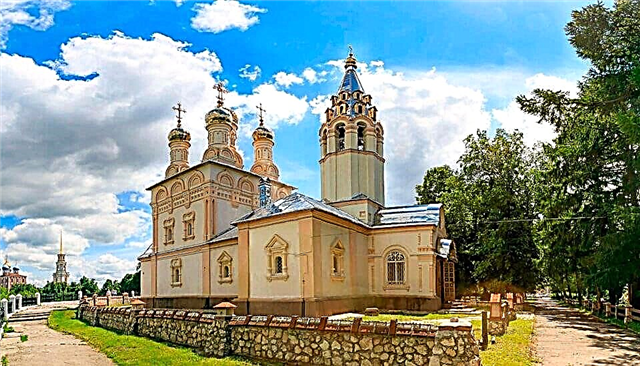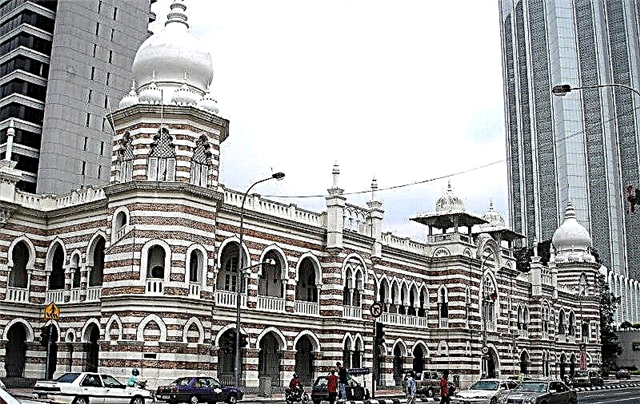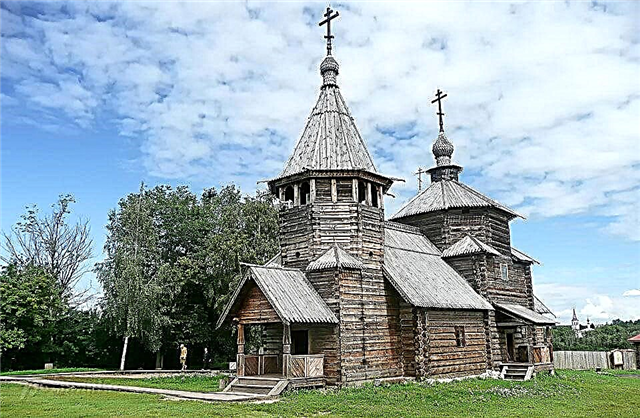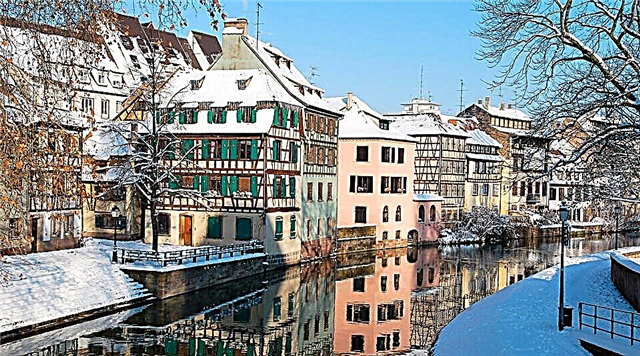Address: Great Britain, Scotland, Edinburgh
First mention: 1093 year
Coordinates: 55 ° 56'55.0 "N 3 ° 12'03.0" W
Content:
Short description
One of the most famous and, at the same time, the most mysterious castles, is located in Scotland, in its capital city of Edinburgh. Due to its long and complex history, architectural style and location, Edinburgh Castle is rightfully the most visited monument of history and architecture in all of Scotland.

View of the castle from Mount Arturovo seat
In addition, according to the results of numerous opinion polls, one can draw a certain conclusion: the castle in Edinburgh in terms of attendance can compete with the Tower of London and even the Palace of Westminster. Everything in this huge castle is interesting without exception - architecture, interior decoration, myths and legends associated with it, and even the road that leads to the fortification. Yes Yes, Edinburgh Castle is not the residence of monarchs, but the most fortified and impregnable fortress... It could not be otherwise, because it is the stronghold of the whole of Scotland, and for a long time the castle, located on an extinct volcano, was called nothing else but "the key to the country"!
The castle, towering on the "Castle Rock", is a favorite place for professional photographers. Photos of Edinburgh Castle, taken from various angles, amaze the imagination and become an adornment of any room, be it a living room of a cottage or an office of a reputable company. At the moment, archaeological excavations are continuing on the territory adjacent to the fortification. It has already been proven that even before the appearance of the architectural structure on the "Castle Rock", ancient people lived here. Of course, they chose this place for themselves after the volcano ceased to be active. Surprisingly, each find of scientists at Edinburgh Castle does not provide answers, but poses new questions for historians.

A bird's eye view of the castle
“To come to the United Kingdom and not visit Edinburgh Castle is an unforgivable mistake!” - say tourists who have already been lucky enough to visit the very “heart” of Edinburgh. The castle in the capital of Scotland, under which the volcano fell asleep forever, is considered the heart of not only the city, but the whole country. The fact is that since ancient times a legend has appeared that said that the one who ruled the Edinburgh Castle belonged to all of Scotland! Probably, it is for this reason that the main castle of the capital of Scotland was only recently opened for tourists and turned into a kind of museum. Even after the Second World War, it entirely belonged to the Ministry of Defense and was even included in the list of fortifications operating in the country.
Naturally, such an amazing history and formidable view of an impregnable castle simply cannot fail to interest millions of tourists. True, the history of Edinburgh Castle is so intricate that it is rather difficult to understand it. In this material, it is worthwhile to dwell on the history of the construction of this castle complex, as well as on those events that throughout its existence were inextricably linked with it.

Castle entrance
Running a little ahead, I would like to clarify that in this article only the most important and most significant dates, officially confirmed by specialists, will be indicated. If you try to describe the entire history of Edinburgh Castle, for this you will have to create a multivolume work. By the way, many facts from books and sections of encyclopedias written in the middle of the 20th century and dedicated to the main castle of Scotland are currently refuted by modern historians and archaeologists. As mentioned above, reputable archaeologists are still working on the territory of the complex, who sometimes manage to shed light on any date or event that occurred in Edinburgh Castle and the adjacent territory. True, most of the questions remain open, many of them relate to the time period when ancient people lived on the extinct volcano.
"Castle Rock" - the oldest history
The first mentions of the appearance of a settlement of people on "Castle Rock" are found in the work of Andrew of Winston, who wrote a huge work, consisting of nine books, which describes in detail the history of all of Scotland.

Castle View from Princes Street
Nine volumes have been called the "metric chronicle of the country": in one of the books, Andrew Winston claims that the first people appeared on "Castle Rock" approximately 1,000 years before the advent of our era. Of course, he does not provide any evidence in his work, and also does not report where he got this information from. Surprisingly, modern archaeologists were able to confirm his version, they found household items of ancient people, which were made 1,000 years before the arrival of Jesus Christ in our world. Modern technology makes it possible to determine the "age" of an object using carbon analysis, but how Andrew Winstonsky got this information will remain a mystery. In 1000 BC, hardly anyone on the territory of modern Scotland kept chronicles that, even if they existed, would never have reached the ancient historian.
In one of the nine volumes of Andrew of Winston, there is also a mention of a fortified structure located on the "Castle Rock", which guarded not the city ... but the virgins. True, these virgins were not just beautiful girls, royal blood flowed in them, therefore they were guarded by the guards until the moment they married, of course, kings or princes.

View of (left to right) Crescent Battery, Royal Palace and Great Hall
The history of the appearance of the fortress on the "Castle Rock"
Let's leave aside the work of Andrew Winston, which, by the way, is still very popular among historians today, and fast forward in time immediately to the 600th year of our era. At that time, according to ancient chronicles on the "Castle Rock" in a fortified structure called Eidyn, a king named Munnidog settled. He was the ruler of a small territory who often indulged in debauchery and organized feasts that often lasted more than a month. After one such feast, naturally, without thinking about anything, Munnidog decided to arrange a bloody battle with the Angles. It is not surprising that his small army was completely destroyed, and the king himself was mortally wounded in the battle. By the way, the name of the castle Eidyn is found only in the 600th year. Prior to this period of time and up to the 16th century inclusive, the fortress in Edinburgh was called "Castle of the Virgins".
After the victory of the Angles over King Munnidog and their capture of the castle on an extinct volcano, one should again travel back in time almost 500 years ahead. The point is that no official information about what happened on the territory of Edinburgh Castle for 5 centuries has not been found today.

View of the buildings of the National War Museum
And the battle of the army of King Munnidog with the Angles is questioned by many historians. The very first document describing a castle on the territory of modern Edinburgh dates back to 1093. This chronicle tells of the death of King Malcolm III. In the "Castle of the Virgins" his widow died of grief, and the king's children managed to hide from enemies through an underground passage during a long siege. By the way, the wife of Malcolm III named Margaret was subsequently canonized. In 1124, the son of Malcolm III managed to avenge the death of his father and return Edinburgh Castle to his disposal.... During the reign of David I, a meeting of the Parliament (!) Of Scotland took place in the fortress on the "Castle Rock". And this despite the fact that before David I, the city of Edinburgh was not the capital of the country. During the reign of David I, the first stone structures appeared on the "Castle Rock": by order of the king, a chapel named after his mother Margaret and the Church of the Holy Virgin Mary were built.
As mentioned above, it is simply impossible to list everything that happened in the castle and with the castle throughout its history in one material. However, you should definitely stop at 1296: on March 8, King Edward I of England unleashed a long bloody war.

Castle Gate in Argyll Tower
Edinburgh Castle after the declaration of war by England was taken in just two months. To list how many times the "Castle of the Virgins" passed from hand to hand before 1357, it is necessary to write a separate article: the Scots wanted independence, and the English kings saw Scotland as part of the United Kingdom. In 1357, King David II and the King of England signed a treaty, according to which Scotland finally gained independence. It is impossible, even approximately, to calculate how many soldiers lost their lives at Edinburgh Castle in the Revolutionary War. 10 years after the signing of the peace agreement, the construction of another tower began in the castle, which was later named in honor of King David II. Alas, at the moment nothing is left of the old building, modern tourists in its place can see the "Battery of the Crescent".
Another bloody battle took place at Edinburgh Castle in 1573. By that time, the fortress was practically impregnable. It was impossible to get to it from three sides because of the steep rocks, and the only road leading to the castle was steep and so narrow that any enemy detachment could be destroyed in a matter of minutes by the defenders of the fortress.

Argyll Battery View
The great commander of Elizabeth I, William Drury, was a talented strategist: he did not throw his soldiers to storm the fortification, because, by and large, by doing so he would have sent them to certain death. By order of the Queen of England, a battery of cannons was built near Edinburgh Castle for almost a month. The days from 17 to 29 May were the most terrible in the history of the "Castle of the Virgins": all the guns that were brought to the fortification began a massive shelling. The fortress was defended by a detachment led by Kirkaldi.
Volleys did not stop even at night, according to chronicles, over 3,000 shells hit Edinburgh Castle in 12 days. The tower of David II and other structures of the fortress were completely destroyed. However, the biggest loss was the destruction of the well. The defenders were left without drinking water and revolted: Kirkaldi and the entire garrison surrendered to the mercy of the victor. Elizabeth I showed mercy and released all the defenders of Edinburgh Castle, but Kirkaldi, along with his brother and a jeweler, cast coins of pure gold with the image of the great Mary Stuart, the Queen ordered to be hanged.

Monument to Douglas Haig in front of the building of the National War Museum
Over the next one and a half centuries, the castle was fortified and destroyed again, people continued to die near its walls. The Scots, despite the fact that they were almost completely exhausted, did not want to have anything to do with the British. This state of affairs continued until 1707, when Scotland became part of Great Britain. In 1728, the authorities of the United Kingdom decided to fortify their strategically important facility and erected several towers on the territory of Edinburgh Castle. with loopholes. In 1745, the Jacobins made their last attempt to capture the "heart of Scotland." They did not succeed in taking the castle, this would require another long-term artillery bombardment, and the walls of the fortress and all its towers and premises were already made of high-strength stone at that time. This was the last battle at the main attraction of Edinburgh.
Edinburgh Castle - A New History
As mentioned above, in this material it is impossible to present even a tenth of the entire history of the castle. In this article, only the most important and significant dates are mentioned, to which the year 1745 can be safely attributed. After 1745, no battles were fought on the territory of Edinburgh, and the castle ceased to function as a fortification, but at the same time it was included in the list of the United Kingdom Ministry of Defense.

Chapel of Saint Margaret
Nevertheless, until 1799, a huge number of new premises were erected on its territory, including the legendary House of the Governor and the Barracks, named by the architect "New". After the end of all the battles, Edinburgh Castle became a fortress-prison, which contained especially dangerous criminals. It was quite difficult to take the fortress by storm, but it turned out to be easy to escape from the prison, which was proved by 49 prisoners in 1811, who easily made a wide opening in the southern part of the castle. The authorities did not take any measures to strengthen the now Edinburgh castle-prison. They simply moved the dungeon, and made the "heart of Scotland" a monument of history and architecture.
In 1818, a major event took place at Edinburgh Castle, not only for Scotland, but for the whole of Great Britain. Walter Scott, who received official permission from the authorities to explore the former fortification, the walls of which are literally soaked in blood, found the crown of Scotland there! Sir Scott, in fairness, originally counted on this find: many documents said that the crown of the monarchs of Scotland was hidden in the "heart" of the country.

Crescent Battery
In 1830, all travelers who came to Edinburgh were generously allowed to visit its main attraction. Fifteen years later, in the chapel of St. Margaret, the very widow of Malcolm III, services began to be held, which attracted the attention of numerous Catholics to Edinburgh Castle. In 1880, large-scale restoration work was carried out in many rooms of one of the main attractions not only in Scotland, but throughout Great Britain. By and large, it was from that period of time that the castle acquired the appearance that a modern tourist who came to the capital of Scotland can still enjoy today.
By the way, Edinburgh Castle became a prison during the Second World War. German prisoners of war were kept in its premises... Not ordinary rank-and-file, but exclusively aces pilots from the Goering Luftwaffe. This is probably the reason why the castle in Edinburgh was not damaged by the bombing. The Germans could not bombard the prison, where their fellow soldiers languished in anticipation of the verdict or release.
Edinburgh Castle today
A tourist who has come to get acquainted with the "heart of Scotland" should definitely approach the castle along the street called the "royal mile". This street is also one of the main attractions in Great Britain.

Mons Meg - 15th century heavy bombardment weapon
However, to describe its history and the buildings located on it, nevertheless, should be in a separate material. After the traveler enters the territory of Edinburgh Castle, first of all, he should definitely visit the Chapel of St. Margaret, because in addition to the fact that it is a functioning Catholic church, it is also considered one of the oldest structures in the entire territory of the United Kingdom. Almost the entire castle is a museum: within the walls of the barracks, the "Governor's House", huge halls and prison cells, there are numerous exhibitions. All these exhibitions tell only about two things: the history of the appearance on the "castle rock" of the fortress, and the struggle of Scotland for its independence.By the way, in one of the rooms you can see the Stone of Destiny itself! According to one legend, it is more than 3,000 years old, and at one time it belonged to the daughter of the legendary Egyptian pharaoh Ramses II! It was she who brought him to the territory of modern Scotland and it was on this stone that all the monarchs of the country were crowned. In 1996, the British authorities, and with the approval of Queen Elizabeth II of Windsor, decided to return the stone to Edinburgh Palace. True, upon his return, the government from London set one condition: as soon as the need for the coronation of the new monarch of the United Kingdom arises, the Stone of Destiny will be temporarily returned to London.

National War Memorial
The stone of fate is, by and large, a mystical artifact. According to another legend, Jacob slept on it, who exactly on this stone saw a wonderful dream in which angels appeared to him, descending to the sinful earth by stairs. In which of these legends to believe, everyone decides for himself, but during the solemn ceremony of his return, along the entire "royal mile" the people and the clergy lined up, bowing their heads before this wonderful stone.
The so-called "Clock Cannon" is also of great interest to all guests of Edinburgh Castle without exception. The "clock cannon" has existed since 1861... Every day (except Christmas and Good Friday), at exactly 13-00, she fires a shot. By the way, a volley from a gun occurs at a specific time, it was previously controlled by a special system associated with another attraction, called the "Ball of Time". This "Ball", which is a precision clock, is 1,238 meters away from Edinburgh Castle. At one time, a cable was laid between the "Time Ball" and the "Clock Cannon", which was the longest electrical connection in the world at the beginning of the 20th century.

Royal Palace
By the way, several "Sentry Cannons" have been replaced so far. The latter is not a massive howitzer, but a light modern artillery piece L119. It is still in service with NATO troops, and a shot from it at 13-00 is made by an artilleryman, who is no longer guided by the "Ball of Time", but by a miniature clock installed directly near the "Clock Cannon".
For those who are planning to visit Edinburgh Castle with a guided tour, it should be noted that a walk along the "royal mile" and bypassing all the premises and attractions of the "heart of Scotland" will take a whole day. By the way, if you get to the castle-fortress at the end of August, you can also enjoy the enchanting spectacle called the festival of the best military bands in the world. This festival opens solemnly: a huge number of Scottish drummers are walking around the courtyard, dressed in national costumes and beating a roll. They are followed by pipers who play the national music of Scotland on their instruments.

Clock cannon
The castle in Edinburgh is huge, and if a professional guide, leading a group through its towers and other premises, tells its entire history in a fascinating way, it will surely be remembered by a tourist for a lifetime.











